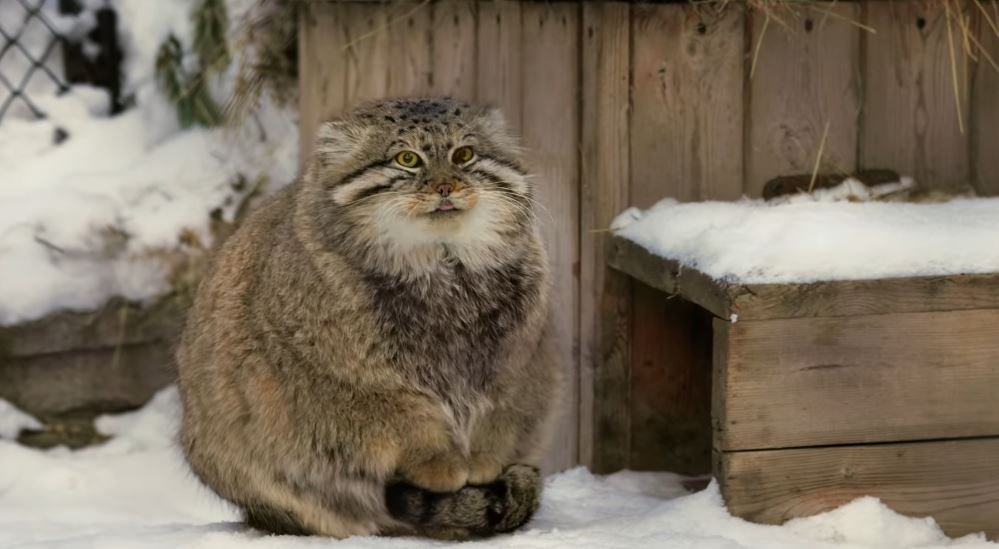
Wild cats of Central Asia include the little Manul cat, sometimes known as Pallas’s cat. The distinctive look and thick coat of this cat have made it famous. Otocolobus manul is its scientific name, and it lives in extreme environments with rocky landscapes, montane steppes, and grasslands.
Key Information About the Manul Cat
| Feature | Details |
|---|---|
| Scientific Name | Otocolobus manul |
| Habitat | Central Asia’s grasslands and rocky areas |
| Diet | Small mammals, including rodents and pikas |
| Size | Body length 46–65 cm; tail length 21–31 cm |
| Weight | Approximately 3 kg (adult) |
| Conservation Status | Near Threatened |
Thick Fur and Distinct Traits
Among feral felines, the Manul cat has the thickest coat. They can withstand subzero temperatures because of this. To help them blend in with their rocky habitats, they have rounded ears set low. They stay warm in subzero temperatures by encircling their bodies with bushy tails.
Distribution and Habitat
Mongolia, Russia, and even the Himalayan regions are home to manul cats in Central Asia. They inhabit altitudes reaching 5,600 meters. Because they are able to hide from predators and bad weather in burrows, these cats like rocky areas. Their fur is able to blend in with its surroundings, making them more difficult to spot.
Ways of Eating and Hunting
Manul cats prey on squirrels, voles, and pikas, among other small mammals. Because they are unable to run after prey, they instead use ambush tactics. Thanks to their camouflage, they can sneak up on their prey undetected. They are able to save energy in cold weather by employing this tactic.
Cycle of Life and Procreation
From December to March, manul cats lay their eggs. In the spring, moms can have litters of 2–6 little kittens. In only four months, a kitten can run around on its own. They are sexually mature by the ninth month. To survive in their hostile environment, they only breed for a brief period of time.
Mechanisms for Continuation
Characteristics of the Manul cat allow it to flourish in chilly environments. Its heavy coat keeps it warm in winter. Their wide paws let them traverse snow and ice just like snowshoes. Their third eyelid shields their eyes from debris and harsh weather.
Dangers and Sustainability
Deforestation and poaching pose a threat to the Manul cat’s habitat. Their habitat is altered by construction of roads and mines. Programs to manage rodents decrease the amount of food they eat. The existence of this secretive species is being ensured through conservation measures, which include captive breeding.
Animals Kept in Captivity and Zoos
Breeding initiatives for Manul cats are active in zoos across the globe. These efforts raise awareness about the species and help keep its genetic variety intact. Because they are so shy, it is unusual to see one in captivity. They act in ways that are consistent with their primal tendencies.
Comparison with Other Wild Cats
| Feature | Manul Cat | Sand Cat | Margay |
|---|---|---|---|
| Habitat | Rocky steppes | Deserts | Rainforests |
| Fur Thickness | Very dense | Moderate | Thin |
| Size | 46–65 cm body | 39–52 cm body | 48–79 cm body |
| Hunting Style | Ambush | Stalking | Tree climbing |
Interesting Facts About the Manul Cat
- The Manul cat’s “grumpy” face is due to its flat facial structure.
- Its fur changes color with the seasons, becoming lighter in winter.
- Unlike other cats, Manuls are poor runners and depend on stealth to catch prey.
- Kittens are born with dark, woolly coats for added warmth.
- They are rarely spotted in the wild due to their secretive nature.
FAQs
1. Where does the Manul cat live?
Manul cats inhabit Central Asia’s rocky steppes and grasslands.
2. Why is the Manul cat called “Pallas’s cat”?
It was named after Peter Simon Pallas, the naturalist who first described it.
3. Can I keep a Manul cat as a pet?
No, they are wild animals and unsuitable for domestication.
4. What does the Manul cat eat?
It preys on small mammals like pikas, voles, and ground squirrels.
5. Why are Manul cats endangered?
Habitat loss, poaching, and rodent control programs threaten their survival.
6. How big is a Manul cat?
Manul cats are about 46–65 cm long, with a tail measuring 21–31 cm.
